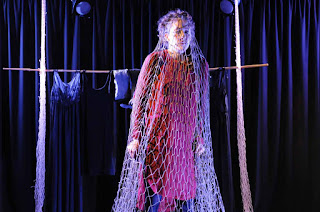Kritik zu Sag was! (Theater Minimus Maximus) von Annemari Parmakson
Fabienne Rohrer, Carina Huber, Martin Birnbaumer (Foto: Stefanie Seidel)
The first performance of the festival was for the youngest audience of this year’s Luaga & Losna – “Sag was!” by Theater Minimus Maximus is for ages 4 and up. Fittingly, the focus of the story is on the experience of a very young child. As the frame of the main story, three children, played by Carina Hubber, Fabienne Rohrer and Martin Birnbaumer, dressed in colourful pajama-like clothes, are playing and dancing, which, in the case of young children, can be the same thing. The manner of movement is playful and has elements of physical comedy, to which the young spectators are quick to respond with laughter.
After a typical kid-like argument about who gets to play which character, the story unfolds of a child, who the parents can not, for the life of them, get to say a word. They try with both the stick and the carrot, but no use. The parents, the uncle and the aunt express themselves in kazoo sounds, which is funny at first, but after a while one can understand why their child is holding his hands on his ears. But it works this way as an accurate representation of the child’s perspective, and also enables a theatre piece about speaking to be made without using any words.
The actors switch characters with the help of a few defining items, such as mops made into hats for the ladies, or a white cloth as diapers for the baby, or a big belt for the tough-acting father. One of the benefits of such a use of props is that costume changes can be done quickly right on stage. However, in some cases it took awhile for the actor to get ready, which resulted in a halt in the tempo of the performance and one of the others doing some aimless action, like crawling around as a baby, to fill the time. It was not clear, where the focus of attention was supposed to be.
Time management is a more general problem in this performance. There was unnecessary repetition of (similar) situations, partly because of the actors rotating the roles, which did not serve any clear purpose. The story, although a good idea, has a very simple structure, and stretched like this over a whole hour, it lacked tension. Such dramaturgical aspects are well reflected by the reactions of the young audience. From the beginning, the children were very eager to watch and engage, but they grew restless quite quickly. Sometimes active whispering among the young audience can be a sign of many thoughts and feelings coming up, which need to be shared. In this case though, it was evident from their turning heads and overall fidgety behaviour, that they had lost contact with the storyworld.
One of the things which still managed to bring their focus back to the stage was shadow theatre – the other main medium of storytelling in the performance besides dance. The simple, yet vivid characters receded behind the screen and became silhouettes. The over the top manner of expression worked even better with another, visual layer of stylization added to it. At times the shadow pictures could only have been a bit neater, e.g. so that the shadows would not cut into each other when they are not supposed to. One of the most interesting shadow images was of the child’s dream: the usual white background of the screen was filled with sweet little red flowers, representing, for the first time in the performance, the inner world of the child, who thus far had mostly just been shown as the object of the parents’ obsessive attention.
In the end, the child finds its voice, although in a different kind of instrument than those of its parents’. Mom and dad are nevertheless delighted, only the sound of the ocarina is a bit quiet and very off-key with the music which kicks in, so there is a weird contrast with the cheery mood of the ending story-wise, and it ends up being anticlimactic. A more resolute approach from the director would have been good, for the ending but more so in general, for cutting out parts which do not serve the purpose of the movement of the story nor the scene. It would be completely fine if the performance was half of its current duration, for example. If the children manage to follow the story through some pauses and games or dance numbers – which at times become things-in-themselves –, the story is potentially easily relatable for them. On a broader level, it is about adults pushing their expectations on a child and the need for the child to find, in their own time, their own way of doing things. This is a good idea to have as the start of a festival of theatre for young audiences.

